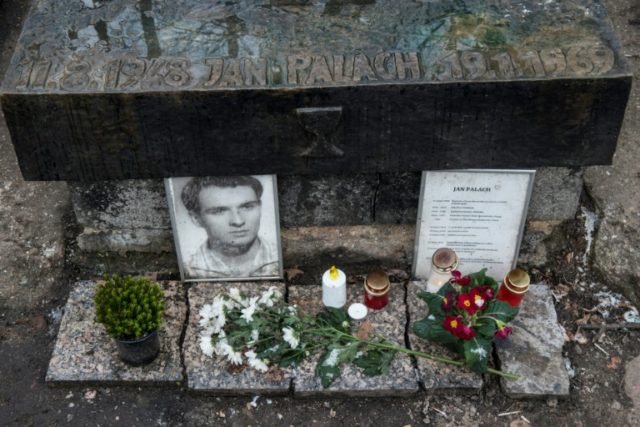Prague (AFP) – Jan Palach was a student activist who burnt himself to death 50 years ago this week to protest at the Soviet-led occupation of then Czechoslovakia.
“He loved history and he was also interested in philosophy,” Ivana Zizkova, who went to school with Palach, told AFP of the young man, an introvert always immersed in books and magazines.
“He was good-looking. Very close to his mother,” added Zizkova, who was in the same class as Palach at the school in the Czech town of Melnik just north of Prague.
“And what was unusual during the Communist era: he dared to argue with the professors when he disagreed with them,” added the now 70-year-old pensioner.
Three years after they passed their school-leaving exams, Palach, studying philosophy at Charles University in Prague, set himself alight in the central Wenceslas Square on January 16, 1969.
He wanted Czechoslovaks to resist a new hardline regime absolutely loyal to the Kremlin, following the Soviet-led invasion of Czechoslovakia in August 1968 which crushed a liberal movement called the Prague Spring.
With burns to 85 percent of his body, Palach died on January 19, aged 20.
His funeral in Prague was attended by 100,000 silent mourners.
– Mobilise the nation –
“I was travelling from Prague to Melnik and in the newspaper I saw a tiny story: ‘Student JP set himself alight in Wenceslas Square,’” recalled Zizkova.
“Then I learnt that it was Honza. Of course I was shocked,” she added, calling Palach by the diminutive of his first name.
“He had something of a genius in him. He could see farther than the rest of us. He tried to mobilise the nation.”
“I admire him, and I still have goosebumps. He sacrificed his life so young,” she said.
Palach was born to a modest family in the village of Vsetaty near Melnik.
His father, who died in 1962, was a confectioner whose shop had been confiscated by the Communists, while his mother was a shop assistant at a kiosk at the local railway station.
“In 1967 and 1968, Jan took part in voluntary work camps in the Soviet Union,” says Jana Beranova, head of the Vsetaty-based Jan Palach Society.
“He was shocked by the contrast between Soviet reality and the propaganda,” she told AFP.
“He refused to succumb to the lethargy that gradually overtook society after the occupation. He called for a general strike — in vain. And then he made his decision,” Beranova said.
At dawn on January 16, 1969, Palach took a train from Vsetaty to Prague.
In his dormitory room, he reviewed his manifesto. It demanded that the regime drop censorship and ban the Zpravy magazine, which had been distributed since August 1968 by the Soviet occupation forces and was spreading fake news.
– Taking responsibility –
At noon he bought two plastic buckets and four litres of petrol in a street adjacent to Wenceslas Square and bearing the name of Jan Opletal, a student killed by the Nazis three decades earlier.
At half past two, Palach arrived at the National Museum at the top of the busy square, poured the petrol over his body and struck a match.
“There are moments in history when you have to do something,” he later managed to murmur in his hospital bed.
Several “human torches” followed his example across eastern Europe, including two Czechs — student Jan Zajic on February 25 and technician Evzen Plocek on April 4 of the same year.
Twenty years later, anti-Communist dissident Vaclav Havel was detained as he laid a flower at the top of Wenceslas Square to commemorate Palach on January 16, 1989, sparking the so-called Palach Week of anti-Communist protests.
Havel became the country’s president after the peaceful Velvet Revolution finally overthrew the Communist regime later in 1989, four years before Czechoslovakia split into the Czech Republic and Slovakia.
“There are some who disapprove of Palach’s act. They believe he could have fought in a different way, without sacrificing his life,” said Beranova, who lives in Vsetaty and teaches history at a Prague grammar school.
“I often think about this myself. Honza loved our nation and country and it’s a shame he’s not with us anymore.”
“But his legacy is important. I tell my students that they must always be active, able to take responsibility for the things that happen in our country,” she added.
Palach was buried at the Olsany cemetery in Prague, but in 1973 the police had his body exhumed, incinerated and moved to Vsetaty to prevent rallies at the grave.
His ashes returned to Olsany after the fall of the Communist regime. Many Czechs pay tribute to him there each January 16.

COMMENTS
Please let us know if you're having issues with commenting.